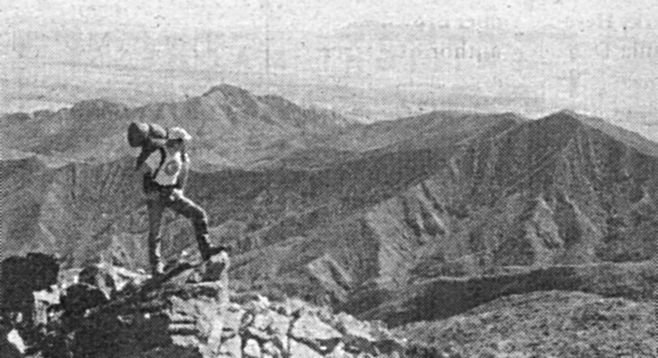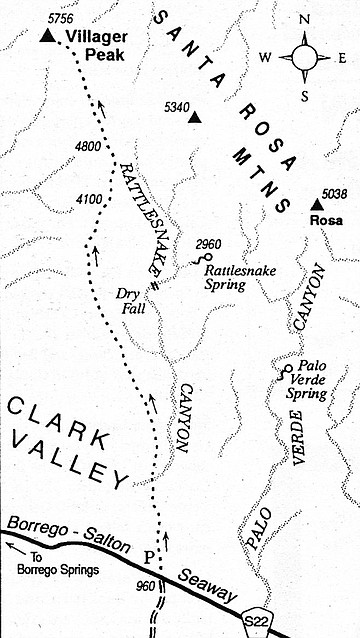 Facebook
Facebook
 X
X
 Instagram
Instagram
 TikTok
TikTok
 Youtube
Youtube

Spotted with weather-beaten piñon pines, Villager Peak in the southern Santa Rosa Mountains rises nearly a mile above the lowlands of Anza-Borrego Desert. Serious “peak baggers” from around the state are drawn to its summit, which due to its high elevation, steadfastly resists any easy approach.
Some people take a full two days to backpack the waterless 13-mile round trip route described here; others like to zip up and down in a single day. As the days grow ever cooler but shorter this season, the latter option only works safely for those who are in top physical shape and who are willing to hit the trail by dawn’s first light. Others are invited to try just the first part of the trek. Simply climb upward until you are “half-tired” and save the other half of your strength for the trip back down. The higher you go, the more rewarding the view. Don’t forget to take along plenty of drinking water.
Park in the north-side turnout at mile 31.8 on Borrego–Salton Seaway, 13 miles northeast of Borrego-Springs. On foot, proceed north toward the east end of a long, sandy ridge 0.5 miles away. North of the ridge, flash floods spilling out of the Santa Rosa Mountains have cut a series of braided washes in a swath about 0.6 miles wide. A faint path marked by small piles of stones takes you over this dissected terrain to the base of the long, ramp-like ridge that trends north. The route soon levels off to a steady gradient averaging about 1000 feet of elevation per mile. Stay on the highest part of the ridge to remain on route, which is at times marked by a rough, informal trail.
Glistening specimens of barrel cactus, hedgehog cactus, and silver, golden, and teddy-bear cholla cactus grace the slopes below 3000 feet elevation. A spiny gauntlet of agave thorns at 3000 feet to 4000 feet may hinder your progress a bit. At 4100 feet (4.3 miles), you walk along the brink of a spectacular drop-off overlooking Clark Valley.

Thereafter, the ridgeline you’re following becomes quite jagged. Piñon juniper and nolina — typical “high desert” vegetation — appear. At 6.5 miles, you finally reach the rounded, 5756-foot summit of Villager Peak. The views are pseudoaerial all around the compass. A clear, calm, moonless night spent here is an unforgettable experience. Despite the glow in the horizon of cities from Los Angeles to Mexicali, the stars above shine fiercely in a charcoal sky. At dawn, the silvery surface of the Salton Sea mirrors the red glow spreading across the east horizon.


Spotted with weather-beaten piñon pines, Villager Peak in the southern Santa Rosa Mountains rises nearly a mile above the lowlands of Anza-Borrego Desert. Serious “peak baggers” from around the state are drawn to its summit, which due to its high elevation, steadfastly resists any easy approach.
Some people take a full two days to backpack the waterless 13-mile round trip route described here; others like to zip up and down in a single day. As the days grow ever cooler but shorter this season, the latter option only works safely for those who are in top physical shape and who are willing to hit the trail by dawn’s first light. Others are invited to try just the first part of the trek. Simply climb upward until you are “half-tired” and save the other half of your strength for the trip back down. The higher you go, the more rewarding the view. Don’t forget to take along plenty of drinking water.
Park in the north-side turnout at mile 31.8 on Borrego–Salton Seaway, 13 miles northeast of Borrego-Springs. On foot, proceed north toward the east end of a long, sandy ridge 0.5 miles away. North of the ridge, flash floods spilling out of the Santa Rosa Mountains have cut a series of braided washes in a swath about 0.6 miles wide. A faint path marked by small piles of stones takes you over this dissected terrain to the base of the long, ramp-like ridge that trends north. The route soon levels off to a steady gradient averaging about 1000 feet of elevation per mile. Stay on the highest part of the ridge to remain on route, which is at times marked by a rough, informal trail.
Glistening specimens of barrel cactus, hedgehog cactus, and silver, golden, and teddy-bear cholla cactus grace the slopes below 3000 feet elevation. A spiny gauntlet of agave thorns at 3000 feet to 4000 feet may hinder your progress a bit. At 4100 feet (4.3 miles), you walk along the brink of a spectacular drop-off overlooking Clark Valley.

Thereafter, the ridgeline you’re following becomes quite jagged. Piñon juniper and nolina — typical “high desert” vegetation — appear. At 6.5 miles, you finally reach the rounded, 5756-foot summit of Villager Peak. The views are pseudoaerial all around the compass. A clear, calm, moonless night spent here is an unforgettable experience. Despite the glow in the horizon of cities from Los Angeles to Mexicali, the stars above shine fiercely in a charcoal sky. At dawn, the silvery surface of the Salton Sea mirrors the red glow spreading across the east horizon.
Comments